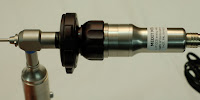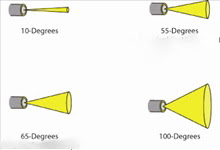Super thin fiberscopes are used to remotely inspect the smallest areas.
Sometimes applications require access through the smallest holes less than 1.0 mm. Typically these super thin borescopes are limited in length and direction of view is forward.
These small inspection areas provide remote visual inspection professionals with many challenges. The access dictates the inspection requirements more than any other factor. The smaller the inspection area the more limited the choice of borescopes available and the number of manufacturers of these micro borescopes.
Applications for Micro Borescopes:
• Engineering Manufacturing. Super thin Fiberscopes provide cost-effective examination of internal structures without tear down.
 • Quality Control. Super thin Borescope instruments allow manufactures to inspect components for defects. Mini borescopes provide the ability to inspect internal components, bore holes, castings and other manufactured items such as turbine blades, automotive components, circuit boards, rifle barrels and welds.
• Quality Control. Super thin Borescope instruments allow manufactures to inspect components for defects. Mini borescopes provide the ability to inspect internal components, bore holes, castings and other manufactured items such as turbine blades, automotive components, circuit boards, rifle barrels and welds.
• Castings. Super thin Fiberscopes can be used to inspect inside casting of engine blocks and other high quality casted components.
At Fiberscope.net you can find a full range of micro borescopes for remote visual inspections.
Sometimes applications require access through the smallest holes less than 1.0 mm. Typically these super thin borescopes are limited in length and direction of view is forward.
These small inspection areas provide remote visual inspection professionals with many challenges. The access dictates the inspection requirements more than any other factor. The smaller the inspection area the more limited the choice of borescopes available and the number of manufacturers of these micro borescopes.
Applications for Micro Borescopes:
• Engineering Manufacturing. Super thin Fiberscopes provide cost-effective examination of internal structures without tear down.
 • Quality Control. Super thin Borescope instruments allow manufactures to inspect components for defects. Mini borescopes provide the ability to inspect internal components, bore holes, castings and other manufactured items such as turbine blades, automotive components, circuit boards, rifle barrels and welds.
• Quality Control. Super thin Borescope instruments allow manufactures to inspect components for defects. Mini borescopes provide the ability to inspect internal components, bore holes, castings and other manufactured items such as turbine blades, automotive components, circuit boards, rifle barrels and welds.• Castings. Super thin Fiberscopes can be used to inspect inside casting of engine blocks and other high quality casted components.
At Fiberscope.net you can find a full range of micro borescopes for remote visual inspections.





